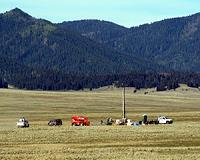| . |  |
. |
Riverside CA (SPX) Mar 04, 2011 Rice, which is sensitive to drought due to its high water requirement, is particularly vulnerable to how global climate change is altering the frequency and magnitude of floods and droughts. If rice plants' combined tolerance to flooding and drought could be improved, however, rice productivity could be protected and even substantially increased. Now plant scientists at the University of California, Riverside have made a discovery that can greatly benefit rice growers and consumers everywhere. The researchers have demonstrated in the lab and greenhouse that rice that is flood tolerant is also better able to recover from a drought. "Flood tolerance does not reduce drought tolerance in these rice plants, and appears to even benefit them when they encounter drought," said Julia Bailey-Serres, a professor of genetics in the Department of Botany and Plant Sciences, who led the research project. Bailey-Serres and her team - Takeshi Fukao, a senior researcher, and Elaine Yeung, an undergraduate student - focused on Sub1A, a gene responsible for flood or "submergence" tolerance in rice and found only in some low-yielding rice varieties in India and Sri Lanka. Sub1A works by making the plant dormant during submergence, allowing it to conserve energy until the floodwaters recede. Rice with the Sub1A gene can survive more than two weeks of complete submergence. Plant breeders have already benefited farmers worldwide - especially in South Asia - by having transferred Sub1A into high-yielding rice varieties without compromising these varieties' desirable traits-such as high yield, good grain quality, and pest and disease resistance. Bailey-Serres's lab found that in addition to providing robust submergence tolerance, Sub1A aids survival of drought. The researchers report that at the molecular level Sub1A serves as a convergence point between submergence and drought response pathways, allowing rice plants to survive and re-grow after both extremes of precipitation. Study results appear in the January issue of The Plant Cell. The journal has the highest impact factor of primary research journals in plant biology. The research paper also has been selected as a recommended read in the Faculty of 1000. Bailey-Serres's lab investigated the drought tolerance of flood-tolerant rice plants because her research team wanted to be sure that the flood tolerance trait, which the lab has studied for many years, did not reduce the ability of the plant to endure some of the other common stresses - such as drought. "We found that Sub1A properly coordinates physiological and molecular responses to cellular water deficit when this deficit occurs independently, as in a time of drought, or following 'desubmergence,' which takes place when flood waters recede," Bailey-Serres said. She explained that after a flood, a period follows when the leaves that have been submerged lose water and become dehydrated. Moreover, because a period of dehydration is part of the natural progression of a flood, Sub1A also happens to have benefits after desubmergence and is therefore important for drought tolerance as well. "Our finding suggests that the plant recovers well from drought by growing new shoots," Bailey-Serres said. "This is something that is also seen with flooding." Next, colleagues of Bailey-Serres at the International Rice Research Institute in the Philippines will test the Sub1A rice for drought tolerance in the field.
Share This Article With Planet Earth
Related Links University of California - Riverside Climate Science News - Modeling, Mitigation Adaptation
 Dry Lake Reveals Evidence Of Southwestern Megadroughts
Dry Lake Reveals Evidence Of Southwestern MegadroughtsLos Alamos NM (SPX) Mar 03, 2011 There's an old saying that if you don't like the weather in New Mexico, wait five minutes. Maybe it should be amended to 10,000 years, according to new research. In a letter published recently in the journal Nature, Los Alamos National Laboratory researchers and an international team of scientists report that the Southwest region of the United States undergoes "megadroughts"-warmer, more a ... read more |
|
| The content herein, unless otherwise known to be public domain, are Copyright 1995-2010 - SpaceDaily. AFP and UPI Wire Stories are copyright Agence France-Presse and United Press International. ESA Portal Reports are copyright European Space Agency. All NASA sourced material is public domain. Additional copyrights may apply in whole or part to other bona fide parties. Advertising does not imply endorsement,agreement or approval of any opinions, statements or information provided by SpaceDaily on any Web page published or hosted by SpaceDaily. Privacy Statement |